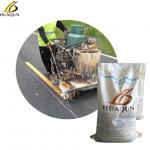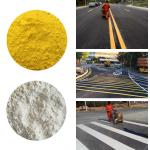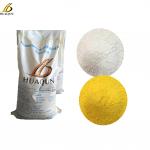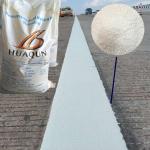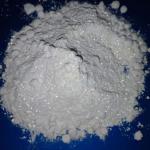Thermoplastic Paint The Ultimate Choice for Reflective and
Weather-Resistant Road Markings
Product
Description
Thermoplastic paint is a type of paint that becomes soft and
moldable when heated and hardens as it cools. It's made from
thermoplastic resins, which are materials that don’t undergo a
chemical change when heated—meaning they can be reshaped or
re-melted without degrading. Key Features of Hot Melt PaintThermoplastic Property:
The defining characteristic of thermoplastic paint is its ability
to melt at high temperatures. When heated (typically between 180°C and 200°C or 356°F to 392°F), the solid paint transforms into a liquid state, making it easier
to apply. Once it cools and hardens, it forms a durable,
wear-resistant surface. Durability:
Thermoplastic paint is known for its long-lasting performance. It is highly resistant to wear and tear from traffic, weather
conditions, and UV exposure, making it an excellent choice for
high-traffic areas. The paint maintains its effectiveness even
under harsh conditions like heavy rainfall, extreme temperatures,
and constant vehicular traffic. Reflectivity:
One of the significant advantages of thermoplastic road markings is
their reflective properties. Glass beads are often embedded in the paint during or immediately
after application. These beads enhance the visibility of the road
markings at night or in low-light conditions by reflecting
headlights, improving safety for drivers and pedestrians. Quick Drying:
After application, thermoplastic paint cools and solidifies
relatively quickly—usually within minutes. This quick drying time allows roads to be opened to traffic soon
after application, minimizing disruption. Eco-Friendly:
Thermoplastic paints are often more environmentally friendly than
traditional solvent-based paints. They typically contain fewer
volatile organic compounds (VOCs), reducing their environmental
impact. Additionally, they have a longer lifespan, meaning less
frequent reapplication and reduced waste.
Specification | Gravity(g/㎥) | 2.1g/㎥ | | Color | Yellow, Orange, Red and etc. | | Heating Temperature | 180℃-220℃ | | Softening Point(℃) | 110℃ | | Coating Appearance | No wrinkles, dots, blisters, cracks,fall-out&stick tyres | | Drying Time(min) | Within 3 minutes | | Chroma Performance | Reverse materials(white) | | Compressive Strength(Mpa) | 26 | | Abrasive Resistance(mg) | 42 | | Alkali Resistance | Great (in saturated solution of calcium hydroxide for 24 hours | | Glass Beads(%) | 19% | | Fluidity(s) | 40s | | Coating Resistance | Resis -10℃ for 4 hours | | Package | 25kg/bag, by plastic woven bag. One 20’container can load Max 26
tons | | Heat Resistance | Under 200℃-220℃ for hours | | Material | C5 Petroleum Resin, CACO3, Wax, Glass Beads, EVA, PE and so on. | | Application | Road marking, straight line, dotted line, curve, oriented
arrow,letter and etc. | | Water Resistance | Great (in water for 24 hours) |
Applications of Thermoplastic Road Marking Paint 1. Road Markings- Lane Dividers: Used for highway lane lines, street lanes, and lanes in parking
lots.
- Pedestrian Crossings: Thermoplastic paint is ideal for pedestrian crossings because it
can withstand heavy foot and vehicle traffic.
- Traffic Symbols & Arrows: Used for marking directional arrows, stop lines, and other
traffic symbols on roads.
- Speed Bumps & Parking Areas: Thermoplastic paint is often applied in parking lots and on speed
bumps for clear demarcation.
2. Street and Highway Markings- Reflective Road Signs: Glass beads are mixed into thermoplastic paint to create
reflective road signs, improving visibility at night or in low
light conditions.
- Road Curbs and Edges: It’s used to mark road curbs or the edges of roads to guide
drivers safely.
3. Airport Runways and Taxiways- Thermoplastic paint is used for runway markings, as it is durable
enough to withstand the wear and tear from aircraft and heavy
traffic.
4. Industrial and Warehouse Markings- Floor Markings: Used in warehouses, factories, and distribution centers for
safety and organization. It helps in designating walkways, hazard
zones, and traffic routes.
- Machinery Safety Markings: Used to highlight machinery or areas where workers need to take
precautions.
5. Parking Lots and Garages- Stall Markings: Thermoplastic paint is widely used for parking lines, numbering,
and directional arrows.
- Visitor Zones: Clear demarcation for visitor parking spaces, entrances, and
exits.
6. Bicycle Lanes- Thermoplastic paint is used to create clear, visible markings for
dedicated bicycle lanes, ensuring safety for cyclists.
7. Sports Fields and Courts- Stadiums and Athletic Courts: Thermoplastic paint is used for marking the boundaries of
basketball courts, soccer fields, and other sports areas due to its
durability and resistance to wear.
8. Public Spaces and Safety Zones- Sidewalks: For demarcating crosswalks, pedestrian lanes, and other public
space markers.
- Hazard Areas: Used for safety warnings, such as marking hazardous zones or
emergency exits in public buildings.
- Construction and Application - Construction Equipment: Commonly used equipment includes hot melt
kettles and road marking machines. The hot melt kettle is used for
heating, melting, and stirring the paint, while the road marking
machine can coat the paint on the road surface to form various
markings.
- Construction Process: First, carry out basic treatments such as
cleaning, grinding, and degreasing on the road surface. Then, put
the paint into the hot melt kettle and heat it to 180-220°C to make
it in a molten and flowing state. Pour it into the insulated hopper
of the marking machine, adjust the gap between the marking hopper
and the ground, push the marking vehicle to draw the lines, and at
the same time, automatically and evenly sprinkle the reflective
glass beads.
- Application Scope: It is suitable for center lines, lane dividing
lines, edge lines, guiding lines, pedestrian crossings,
intersections, parking lots, etc., where there is a lot of vehicle
wheel rolling. It has a good effect on both asphalt and cement road
surfaces.
Technical Specification
| Density(g/cm3) | 1.8-2.3 | | Softening point (℃) | 90-125 | | Compressive Strength(MPa) | ≥12 | | Glass bead content(%) | 0-30% | | Liquidity | 35±10 | | Packing | 25kg/bag | | Color | White/Yellow/Blue/Red/Green/Customized | | Executive standard | JT/T280-2004/AASHTO/BS3262/Customized | | Appearance | Powder | | Construction temperature | 180℃-220℃ | | Whiteness | 70-85(Customized) | | Inverse coefficient | 50-550 | | Warranty | 12 months | | Storage Method | Avoid light and moisture | | Packing Size | 45×70×5CM |
|
